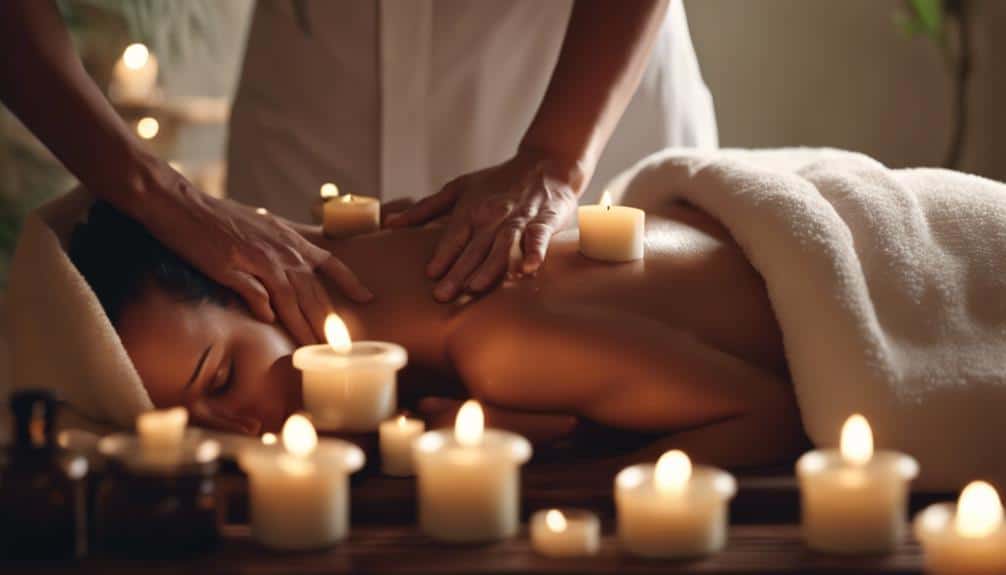Embracing a routine of monthly massages offers a holistic approach to enhancing your overall well-being and addressing physical and mental health. This consistent practice not only provides relief from chronic pain, enabling you to engage in daily activities with renewed vigor, but also fosters mental balance, reduces symptoms of depression and anxiety, and promotes relaxation. You can start a transformative journey toward a healthier and more energized life by tailoring the frequency and type of massage to your specific needs. Integrating these sessions into your self-care regime can significantly improve your quality of life and empower you with strategies for managing stress and discomfort.
Further exploration can reveal more profound insights into optimizing your health through massage.
Key Takeaways
- Monthly massages significantly reduce stress levels and muscle tension, enhancing mental well-being.
- Routine sessions alleviate chronic low back and neck pain, improving daily functionality and quality of life.
- Consistent massages foster enhanced circulation, promoting healing and reducing pain for better physical alignment.
- Regular massage therapy empowers individuals in chronic pain management, offering a transformative improvement in physical and mental health.
- Monthly massages in self-care practices foster mental balance and support the body’s natural healing processes.
Unveiling Massage Benefits
Addressing both physical and mental health, regular massage therapy emerges as proof of transformative practice, offering significant relief from chronic pain and enhancing overall well-being. The benefits of massage extend beyond temporary relaxation, delving deep into health and wellness by reducing chronic low back and neck pain. Pain alleviation is not just about physical comfort; it marks a critical step towards reclaiming one’s quality of life, enabling people to engage in daily activities with renewed vigor and less discomfort.
Moreover, massage therapy offers profound mental health benefits. In a world where depression and anxiety increasingly encroach upon the lives of many, massage therapy provides a beacon of hope. By alleviating symptoms associated with these mental health challenges, massages offer a dual benefit. They improve physical health and promote mental well-being, creating a holistic approach to health that resonates with a broad audience seeking solace and healing.
The popularity of massage for health and wellness purposes, embraced by nearly half of massage consumers, underscores its effectiveness and appeal. It proves the power of touch in fostering a sense of belonging and well-being among those who partake in its benefits.
Optimal Massage Frequency
Comprehending the essential frequency for receiving massages is vital for maximizing the benefits of this therapeutic practice. An ideal weekly schedule can vary significantly among people, depending on specific needs such as stress levels, muscle tension, and injury recovery. Regular, consistent massages are crucial in addressing immediate physical ailments and contributing to long-term health and well-being.
Ideal Weekly Schedule
Tailoring the frequency of your massage sessions to your specific needs is vital to optimizing your health and well-being. Adding regular massages to your weekly schedule can significantly enhance your quality of life, especially if you’re dealing with persistent pain or high-stress levels.
Here’s a guide to help you understand the ideal frequency:
| Frequency | Ideal For |
|---|---|
| Weekly Massage | Persistent pain and high-stress |
| Bi-weekly | Moderate stress and ongoing concerns |
| Monthly | General relaxation and well-being |
| Occasionally | Stress management without specific concerns |
Choosing the proper schedule for your massages is essential in maintaining and preventing physical and mental health issues. It also ensures that you feel a sense of belonging and support in your journey towards a healthier, happier you.
Benefits of Regularity
Embracing a consistent massage routine that aligns with ideal frequency guidelines can significantly improve chronic conditions and boost overall health and mental well-being. Perfect recommendations suggest a monthly 80-minute session for general wellness, effectively reducing stress levels and muscle tension. This regularity supports circulation, enhances muscle relaxation, and fosters mental balance, creating a sense of belonging and connection to one’s self-care practices.
For those recovering from recent or intense injuries, a more intensive schedule of one 50-minute session weekly for two to three weeks is advised, targeting specific areas of concern. The research underscores the lasting impact of such a regimen, showing significant improvements in both physical and mental health, proving the transformative power of monthly massages.
Weekly Vs. Monthly Sessions

Choosing between weekly and monthly massage sessions hinges on individual needs, ranging from intensive pain management to overall wellness and stress prevention. The frequency of massage therapy is a personal choice that significantly depends on an individual’s physical condition, daily stress levels, and wellness goals.
Weekly massages are highly recommended for those dealing with persistent pain or undergoing high levels of stress. This more frequent approach allows for consistent relief and is a proactive measure in managing symptoms. For individuals experiencing moderate stress or ongoing issues, bi-weekly sessions can offer a balanced approach, providing timely relief while maintaining flexibility in one’s schedule.
On the other hand, monthly massages are ideal for those looking to promote relaxation and overall well-being. This cadence supports regular maintenance, helping to prevent the buildup of muscle tension and stress. Even occasional massages, without the commitment to a regular schedule, can offer significant benefits, contributing to a sense of relaxation and well-being.
You are incorporating regular massage therapy into your routine, monthly or more frequently, fostering a sense of belonging to a community prioritizing health and wellness. By understanding your individual needs and lifestyle, you can tailor your massage therapy schedule to transform your life effectively.
Chronic Pain Transformation
Chronic pain often serves as a debilitating barrier, significantly impairing one’s capacity to engage fully in daily activities and enjoy life’s moments. Introducing monthly massages into a health regimen offers a promising avenue for alleviating chronic discomfort and enhancing overall functionality. By prioritizing this form of therapy, persons may experience a transformative improvement in both physical and mental well-being, paving the way for a more active and fulfilled life.
Alleviating Chronic Discomfort
Monthly massages have been shown to alleviate significantly chronic discomforts such as back and neck pain, transforming the way people experience and manage their pain. Through the practice of regular massage therapy, individuals suffering from persistent symptoms find not just temporary relief but a significant transformation in their chronic pain management routine. The consistency of receiving monthly massages, especially those lasting around 80 minutes, offers a systematic approach to tackling the relentless discomfort that chronic conditions can impose.
This not only aids in reducing the intensity of chronic low back and neck pain but also empowers people by providing them with a manageable and effective strategy for relief. Regular massage therapy becomes critical in the journey towards a more comfortable and pain-reduced life.
Enhancing Daily Functionality
Embracing monthly massages is pivotal in transforming daily functionality for people struggling with chronic pain. These sessions enhance a sense of well-being and improve overall quality of life through the power of touch, alleviating the physical discomfort that hampers daily activities and allowing individuals to engage more fully in their lives.
Consider the following benefits:
- Improved Circulation: Enhanced blood flow nourishes tissues, promoting healing and reducing pain.
- Reduction in Muscle Tightness: Targeted techniques relieve tension, fostering greater mobility and flexibility.
- Elevated Mental Health: Massage’s soothing effects decrease stress and anxiety, contributing to a more vital, more resilient mental state.
Monthly massages offer a lifeline to those seeking relief from the relentless grip of chronic pain, opening the door to a life marked by greater ease and enjoyment.
Mental Health Miracles

In mental health care, routine monthly massages have emerged as a transformative practice. They significantly reduce symptoms of depression and anxiety to foster an enhanced state of mental well-being. This holistic approach to mental health leverages the power of touch to unleash emotional balance and resilience. By integrating regular massages into their healthcare routine, people report significant improvements in their mood, experiencing a sense of calm and restoration that permeates their daily lives.
The alleviation of stress and anxiety through these sessions has been extensively documented, demonstrating how this form of therapy is an essential component in the management of mental health. The benefits extend beyond immediate relaxation, improving sleep quality for mental health recovery and maintenance. This improved rest cycle reinforces the body’s natural healing processes, nurturing a more profound sense of well-being.
Furthermore, the consistent practice of receiving monthly massages fosters a stronger mind-body connection, empowering individuals to become more attuned to their physiological and emotional needs. This awareness is crucial in reducing anxiety levels and enhancing the quality of life, making monthly massages not just a luxury but a necessity for those seeking to improve their mental health and navigate life with grace and ease.
Physical Alignment Improvements
Beyond enhancing mental health, regular massages also offer significant benefits for physical alignment, reducing muscle tension, and promoting better posture. The journey towards achieving and maintaining ideal physical alignment is a nurturing and transformative process involving regular care and attention to our body’s needs. Massages facilitate a harmonious balance within our musculoskeletal system by reducing muscle tension and promoting proper posture.
Here are three critical ways in which monthly massages contribute to improvements in physical alignment:
- Reduction of Muscle Tension: Regular massages help loosen tight muscles, reducing strain on the body’s alignment. This is particularly beneficial for those who experience chronic tension due to lifestyle or occupational habits.
- Enhancement of Musculoskeletal Structure: By targeting specific areas of tension, massages contribute to repositioning the body’s structure, improving balance, and reducing the risk of injuries.
- Alleviation of Muscle Imbalances: Consistent care through massages addresses and corrects muscle imbalances, supporting the body in maintaining an ideal posture and alignment.
Understanding the importance of physical alignment underscores the value of integrating regular massages into our self-care routine. It’s not solely about relaxation; it’s about fostering a body that moves with ease and strength, free from the constraints of muscle tension and misalignment.
Athletic Performance Enhancement
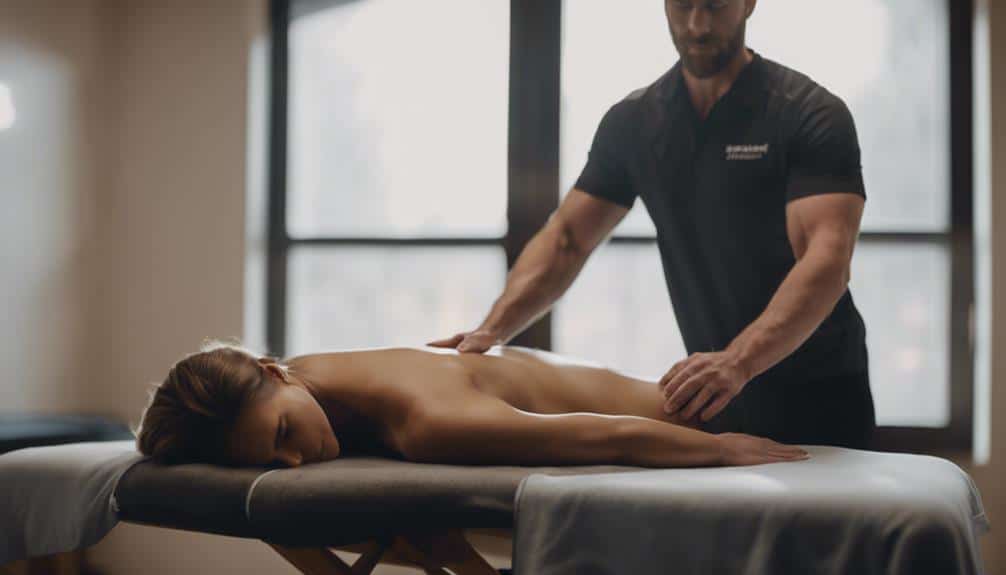
Regular massages reveal significant advantages for athletes, including enhanced flexibility, reduced muscle tension, and improved range of motion, all essential for elevating athletic performance. Integrating massage therapy into an athlete’s routine is not merely about physical upkeep; it’s a strategic approach to ensuring longevity and resilience in their sporting career; through the deliberate manipulation of soft tissues, massage therapy aids in injury prevention by maintaining muscles in their best state, therefore allowing athletes to push their boundaries safely.
Moreover, the recovery period post-intense workouts are notably reduced, thanks to the accelerated muscle healing facilitated by improved blood circulation, a direct benefit of regular massage sessions. This translates to more efficient training cycles and minimizes downtime due to injuries, keeping athletes on track toward achieving their performance goals.
Beyond the physical enhancements, massage therapy’s psychological benefits cannot be overstated. The release of endorphins during a massage session contributes to an improved mood, a reduction in symptoms of depression and anxiety, and an overall sense of well-being. This elevated mental state is crucial in supporting the all-encompassing wellness necessary for peak athletic performance, underscoring the symbiotic relationship between sports excellence’s physical and emotional facets.
Stress and Relaxation Techniques
While the holistic benefits of massage therapy greatly enhance athletic performance, addressing stress through relaxation techniques plays an equally vital role in maintaining an athlete’s overall health and mental well-being. Incorporating these practices under the guidance of a skilled massage therapist can offer profound advantages, especially when combining relaxation techniques with deep tissue massage to target both physical and mental stress triggers.
Here are three essential relaxation techniques that can notably reduce stress levels:
- Deep Breathing Exercises: Simple yet potent, deep breathing helps regulate the stress response and can be easily integrated into daily routines or performed during sessions with a massage therapist.
- Progressive Muscle Relaxation (PMR): This technique involves tightening and relaxing different muscle groups combined with deep breathing. When practiced regularly, PMR can significantly alleviate physical tension and stress and is particularly effective when combined with deep tissue massage to release muscle knots.
- Mindfulness Meditation: Cultivating mindfulness can enhance an athlete’s focus, reduce stress, and improve overall mental health. Integrating mindfulness into massage therapy sessions can amplify relaxation, fostering a more profound sense of calm and well-being.
Embracing these relaxation techniques as part of a holistic approach to stress management can transform an athlete’s performance and quality of life.
Pain Management Strategies
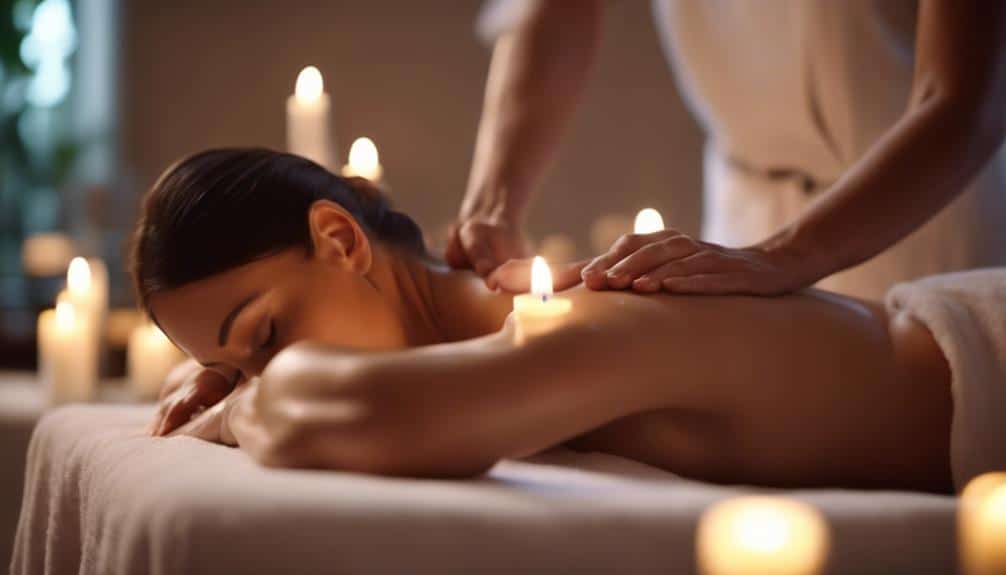
As we move into the domain of pain management strategies, it’s crucial to recognize the importance of identifying the root causes of discomfort. Monthly massages have emerged as a powerful tool in providing adequate relief by addressing these underlying issues, ensuring a comprehensive approach to managing chronic pain. This section will explore how regular massage sessions alleviate immediate symptoms and contribute to long-term wellness and pain reduction.
Identifying Pain Sources
In monthly massages, identifying the sources of pain is a vital step in formulating effective pain management strategies. Understanding the root cause of pain allows massage therapists to tailor their techniques, ensuring each session targets specific areas of discomfort. This approach enhances the therapeutic benefits of massage and fosters a deeper connection between client and therapist, promoting a sense of belonging and understanding.
- Recognizing and Discussing Pain Sources: Effective pain management begins with discussing your pain points.
- Customizing Sessions: Based on your feedback, massage therapists can personalize your massage for optimal relief.
- Addressing Pain Triggers: Focused sessions lead to more beneficial outcomes by targeting the underlying causes of pain.
Effective Relief Techniques
Effective relief techniques, such as massage therapy, have been proven to mitigate chronic pain significantly, offering a pathway to improved physical and mental health. Specifically, individuals suffering from persistent back and neck pain can find solace and relief through targeted massage therapies. Techniques like Swedish and deep tissue massage are particularly adept at addressing muscle tightness and alleviating discomfort, presenting a focused pain management strategy.
Regular monthly massages assist in managing these pains and promote overall well-being, markedly enhancing one’s quality of life. Studies have illustrated that massage therapy can reduce symptoms of depression, underscoring its role in improving mental health. Adopting consistent monthly massages as a proactive approach to pain management can lead to profound improvements in physical and emotional well-being.
Selecting Your Ideal Massage
Selecting the appropriate massage can significantly enhance your physical and mental well-being, so it’s essential to contemplate your preferences and goals. Understanding the various massage types and how they align with your specific needs is fundamental to achieving the most from your massage sessions. It’s not just about indulging in relaxation but about nurturing your body’s particular demands, which can vary significantly from one person to another.
To guide you in selecting your ideal massage, consider the following:
- Research Various Massage Techniques: Delve into massage types, from Swedish and Deep Tissue to specialized therapies like Shiatsu or Reflexology. Each has distinct benefits and methods tailored to different wellness goals.
- Communicate Openly With Your Therapist: Before starting your session, share your expectations and any discomforts or areas needing attention. This ensures the therapy is tailored to your needs, enhancing the effectiveness of the massage.
- Consider Complementary Therapies: Pairing massage with practices like yoga or aromatherapy can magnify the benefits, offering a holistic approach to your well-being.
Communicating With Your Therapist
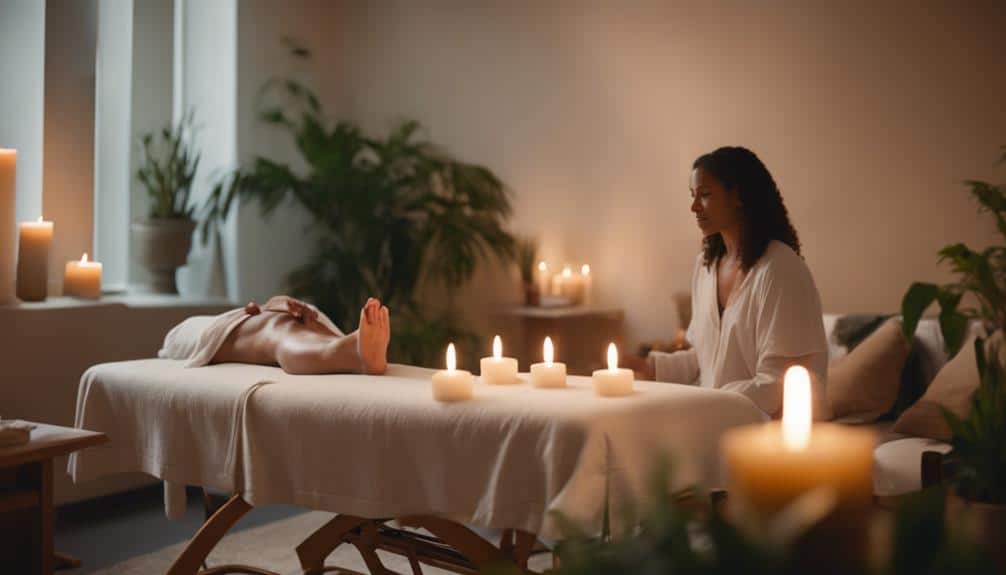
Successful communication is crucial in creating a massage experience that meets and surpasses expectations. Clients must communicate their preferences, including discomfort and the desired pressure level, to allow the therapist to adapt their techniques accordingly. Such open dialogue guarantees that each session is customized to address your specific concerns, enhancing the overall benefit and satisfaction gained from your massage therapy.
Expressing Preferences Clearly
Understanding and articulating your preferences clearly to your massage therapist is essential for tailoring the session to meet your specific needs and enhance your overall massage experience. Effective communication is critical to achieving the most beneficial and personalized massage experiences possible. Here are three vital points to keep in mind:
- Identify Areas of Focus: Let your therapist know which areas require more attention.
- Express Any Discomfort: Communication during the session guarantees adjustments can be made for your comfort.
- Share Medical History: Informing your therapist of any medical conditions helps tailor the session safely around your needs.
Adjusting Pressure Levels
Given the importance of a customized massage experience, communicating your pressure preferences to your therapist is essential to ensure the session meets your needs and comfort levels. This open line of communication allows for the adjustment of pressure levels throughout the massage, enhancing both comfort and effectiveness. By clearly conveying your needs, you empower your therapist to tailor the massage to your preferences, ensuring you receive the maximum therapeutic benefits.
This dialogue is not just about stating preferences; it’s about creating an ongoing conversation that adjusts as the session progresses. Such communication fosters a deep sense of belonging and connection, making each massage a truly personalized experience that aligns with your expectations and comfort zone.
Discussing Discomfort Promptly
Prompt communication about any discomfort during a massage is essential. This lets your therapist modify pressure or techniques to enhance safety and comfort. Discussing discomfort promptly ensures your massage is tailored to your needs and preferences, fostering a collaborative relationship with your therapist. This open dialogue is critical for avoiding injuries and providing a positive massage experience.
To engage further, consider these points:
- Clear communication about discomfort allows for immediate adjustments, ensuring your comfort.
- Addressing any discomfort helps prevent potential injuries, safeguarding your well-being.
- Open dialogue enhances the therapeutic relationship, leading to more effective and enjoyable massages.
Combining Therapeutic Methods
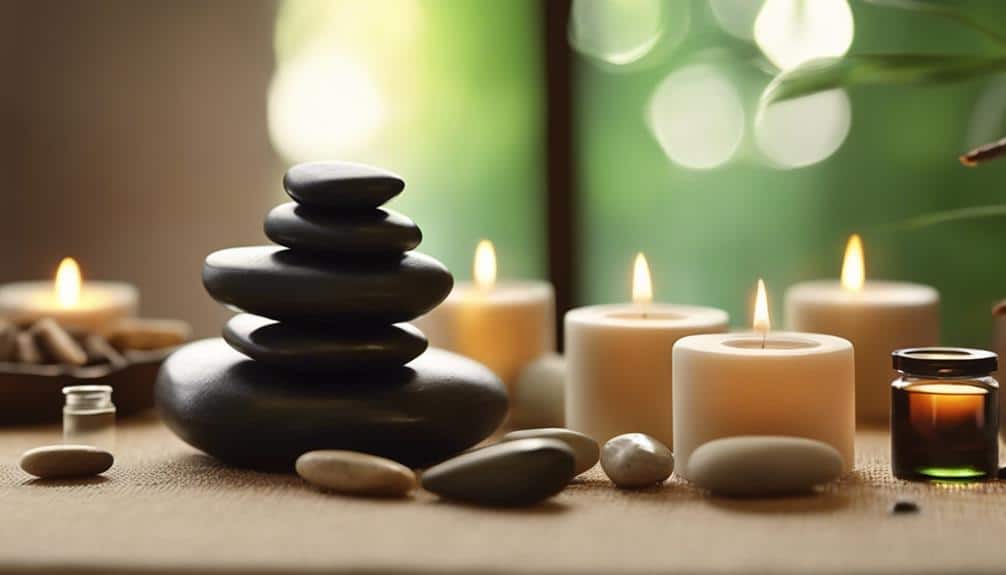
Integrating various therapeutic techniques, such as massage, yoga, aromatherapy, and heat/cold therapies, frequently results in a more profound enhancement of overall well-being. This holistic approach encourages a synergy that maximizes the health benefits attainable through unique practices alone. Individuals can tailor their therapeutic experience to align with specific health goals and preferences by researching different techniques and communicating openly with the therapist.
Healthcare providers must be consulted for specific medical conditions before combining therapies to guarantee safety and effectiveness. This precautionary step safeguards against potential adverse interactions between treatments. Discussing session length, possible side effects, and expected post-massage effects with the therapist further customizes the treatment, ensuring it meets personal needs while avoiding unintended consequences.
Identifying individual goals and preferences plays a significant role in optimizing the therapeutic benefits of combining different methods. This personalized approach enhances physical well-being and nurtures a sense of belonging and care within the therapeutic environment. It’s a journey towards health that respects uniqueness and encourages active participation in the healing process.
Post-Massage Care Tips
To maximize the benefits of your massage, following a set of post-massage care practices that support your body’s recovery and enhance the therapeutic effects is essential. After a massage, your body begins to recalibrate, adjusting to the reduction in stress and improvement in blood flow. Implementing the appropriate care strategies can greatly amplify these benefits, fostering a more profound sense of well-being and belonging.
Here are three essential post-massage care tips:
- Stay Hydrated: Increase your water intake to help flush out toxins released during your massage session. Proper hydration supports enhanced blood flow and reduces stress-related toxins in the body.
- Take a Warm Bath: Submerging in warm water can further relax your muscles and soothe any residual soreness. This practice not only prolongs the feeling of relaxation but also aids in reducing stress and improving blood circulation.
- Avoid Strenuous Activities: Give your body the rest it needs by removing heavy physical exertion. Allowing your body to absorb the benefits of the massage fully can lead to more pronounced improvements in stress levels and blood flow.
Incorporating these practices into your post-massage routine can significantly enhance the transformative power of regular massage therapy.
Recognizing Body Signals

Understanding the subtle cues our bodies send us is critical for recognizing when and where we hold tension, which can significantly impact our overall well-being. Many of us unknowingly harbor this tension in our shoulders, a common repository for daily stress that, if left unchecked, can lead to migraines triggered by neck pain. Despite previous attempts to alleviate this discomfort through practices like yoga, some find that these methods do not fully address the deep-seated tension in their shoulders and neck.
In pursuit of relief, turning to muscle relaxers prescribed by a doctor is an option, yet it prompts many to explore alternative therapies, such as massage. Communicating specific needs to massage therapists, particularly about focusing on the neck and shoulders, can enhance the therapeutic experience to a great extent. Acknowledging the body’s response post-massage, including odd sensations like light-headedness or the sudden release of muscle knots, is a normal part of the healing process. These reactions indicate the body reclaiming its range of motion. They testify to the importance of listening to and understanding our body’s signals for a healthier, more connected life.
Setting Realistic Expectations
Starting on the path of monthly massages necessitates establishing practical expectations about the gradual healing and relaxation process. Embracing this journey into your self-care routine involves recognizing that the path to improved health and well-being is a marathon, not a sprint. It’s about committing to oneself and understanding the cumulative nature of massages’ benefits.
Here are three essential points to ponder:
- Patience is Key: Significant physical and mental wellness improvements may not be instantaneous but will develop with consistent monthly sessions.
- Consistency Fuels Transformation: Incorporating massage every month into your self-care routine helps compound the benefits over time, making each session more effective than the last.
- Manage Expectations: Immediate results may not always be apparent after just one massage, but the commitment to this practice is a commitment to a healthier, more relaxed you.
Frequently Asked Questions
Is It Good to Get a Massage Every Month?
Receiving a monthly massage is beneficial for maintaining overall well-being, managing chronic pain, and enhancing mental health. It aligns with general wellness suggestions and is supported by many people seeking health and wellness enhancements.
Can Monthly Massages Change Your Life?
Regular massage therapy has the potential to impact one’s life significantly. It offers benefits such as reduced pain, lower anxiety, better sleep, and improved circulation, collectively contributing to a heightened sense of well-being and health.
How Many Massages Should You Get a Month?
The ideal number of monthly massages varies, like a garden requiring regular care to flourish. One 80-minute session monthly is advised for general well-being, while specific injuries may necessitate weekly attention.
How Often Should the Average Person Get a Massage?
The average person should consider receiving a massage at least once a month to maintain overall well-being. However, those with specific or intense injuries might benefit from brief weekly sessions.
Conclusion
Massage therapy is an effective way of promoting holistic well-being. Its benefits include alleviating physical pain, reducing stress, and improving sleep quality. Massage therapists use techniques such as Swedish massage, deep tissue massage, and hot stone massages to treat chronic conditions such as joint pain, chronic back pain, and muscle tension. Regular massage therapy can positively impact your daily life, improving your quality of life and overall wellness routine.
Massage therapy is an effective way of reducing mental stress and promoting mental clarity. The physical touch of massage can aid in injury recovery, muscle relaxation, and tissue repair. Massage therapy can also improve blood flow and circulation, lowering blood pressure and blood sugar levels. Regular massage therapy sessions aid in stress reduction by decreasing cortisol levels and promoting a sense of relaxation. Frequent massages can also stimulate the production of white blood cells, helping the body fight against waste products and toxins.
If you get occasional massages, consider booking regular sessions to get the best benefits from massage therapy. Many locations offer monthly memberships and frequent session packages to make scheduling and maintaining a massage schedule more accessible. Massage therapy can provide additional pain relief and aid in injury prevention for those with acute pain issues or chronic muscle pain. You can also try additional services, such as aromatherapy or corporate massage, to enhance your massage session. Contact your nearest massage studio or location for details on the array of massage techniques and types available.
